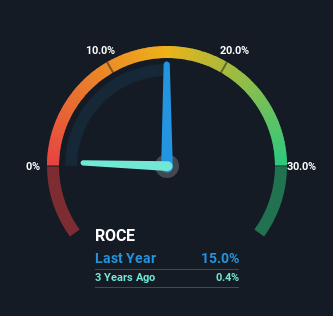- India
- /
- Auto Components
- /
- NSEI:ALICON
Returns On Capital Signal Tricky Times Ahead For Alicon Castalloy (NSE:ALICON)
Did you know there are some financial metrics that can provide clues of a potential multi-bagger? One common approach is to try and find a company with returns on capital employed (ROCE) that are increasing, in conjunction with a growing amount of capital employed. Ultimately, this demonstrates that it's a business that is reinvesting profits at increasing rates of return. However, after briefly looking over the numbers, we don't think Alicon Castalloy (NSE:ALICON) has the makings of a multi-bagger going forward, but let's have a look at why that may be.
What Is Return On Capital Employed (ROCE)?
If you haven't worked with ROCE before, it measures the 'return' (pre-tax profit) a company generates from capital employed in its business. Analysts use this formula to calculate it for Alicon Castalloy:
Return on Capital Employed = Earnings Before Interest and Tax (EBIT) ÷ (Total Assets - Current Liabilities)
0.15 = ₹992m ÷ (₹11b - ₹4.8b) (Based on the trailing twelve months to December 2023).
Thus, Alicon Castalloy has an ROCE of 15%. By itself that's a normal return on capital and it's in line with the industry's average returns of 15%.
View our latest analysis for Alicon Castalloy

Above you can see how the current ROCE for Alicon Castalloy compares to its prior returns on capital, but there's only so much you can tell from the past. If you're interested, you can view the analysts predictions in our free analyst report for Alicon Castalloy .
What Does the ROCE Trend For Alicon Castalloy Tell Us?
On the surface, the trend of ROCE at Alicon Castalloy doesn't inspire confidence. To be more specific, ROCE has fallen from 28% over the last five years. However it looks like Alicon Castalloy might be reinvesting for long term growth because while capital employed has increased, the company's sales haven't changed much in the last 12 months. It's worth keeping an eye on the company's earnings from here on to see if these investments do end up contributing to the bottom line.
On a side note, Alicon Castalloy has done well to pay down its current liabilities to 42% of total assets. That could partly explain why the ROCE has dropped. Effectively this means their suppliers or short-term creditors are funding less of the business, which reduces some elements of risk. Since the business is basically funding more of its operations with it's own money, you could argue this has made the business less efficient at generating ROCE. Keep in mind 42% is still pretty high, so those risks are still somewhat prevalent.
What We Can Learn From Alicon Castalloy's ROCE
In summary, Alicon Castalloy is reinvesting funds back into the business for growth but unfortunately it looks like sales haven't increased much just yet. Since the stock has gained an impressive 42% over the last five years, investors must think there's better things to come. But if the trajectory of these underlying trends continue, we think the likelihood of it being a multi-bagger from here isn't high.
One final note, you should learn about the 2 warning signs we've spotted with Alicon Castalloy (including 1 which is significant) .
While Alicon Castalloy may not currently earn the highest returns, we've compiled a list of companies that currently earn more than 25% return on equity. Check out this free list here.
New: Manage All Your Stock Portfolios in One Place
We've created the ultimate portfolio companion for stock investors, and it's free.
• Connect an unlimited number of Portfolios and see your total in one currency
• Be alerted to new Warning Signs or Risks via email or mobile
• Track the Fair Value of your stocks
Have feedback on this article? Concerned about the content? Get in touch with us directly. Alternatively, email editorial-team (at) simplywallst.com.
This article by Simply Wall St is general in nature. We provide commentary based on historical data and analyst forecasts only using an unbiased methodology and our articles are not intended to be financial advice. It does not constitute a recommendation to buy or sell any stock, and does not take account of your objectives, or your financial situation. We aim to bring you long-term focused analysis driven by fundamental data. Note that our analysis may not factor in the latest price-sensitive company announcements or qualitative material. Simply Wall St has no position in any stocks mentioned.
About NSEI:ALICON
Reasonable growth potential with adequate balance sheet and pays a dividend.
Similar Companies
Market Insights
Community Narratives



